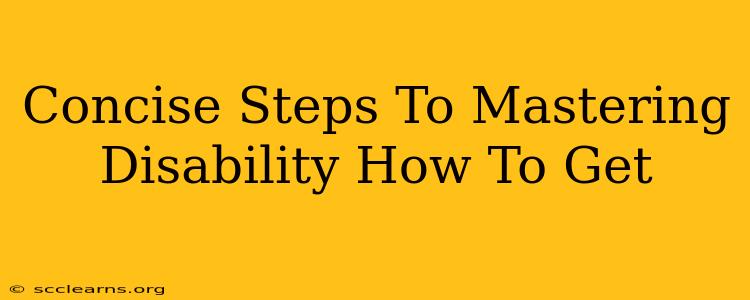Navigating the disability claim process can feel overwhelming, but with a strategic approach, you can significantly improve your chances of approval. This guide provides concise steps to help you master the process and achieve a positive outcome.
Understanding the Claim Process: Key Stages
Before diving into the steps, it's crucial to understand the general flow of a disability claim. This typically involves:
- Application: Completing the initial application forms accurately and comprehensively. This is your foundational step; errors here can cause significant delays.
- Evidence Gathering: Collecting and submitting medical records, therapy notes, and other documentation supporting your disability claim. Strong evidence is paramount.
- Review Process: The Social Security Administration (SSA) or relevant agency reviews your application and supporting documents. This stage may involve interviews or further medical evaluations.
- Decision: You receive a decision regarding your eligibility for disability benefits. This decision may be an approval, a denial, or a request for further information.
- Appeals (if necessary): If your claim is denied, you have the right to appeal the decision through a series of administrative levels.
Concise Steps to Maximize Your Chances of Approval
1. Complete a Thorough Application:
- Accuracy is Key: Double-check every detail on your application. Inaccuracies or omissions can lead to delays or denial.
- Detailed Description: Clearly describe your limitations and how they affect your ability to work. Be specific about your symptoms, their frequency, and their impact on daily activities. Use strong verbs.
- Functional Limitations: Focus on what you can't do because of your disability. This is vital for demonstrating your inability to perform substantial gainful activity (SGA).
2. Gather Compelling Medical Evidence:
- Comprehensive Records: Collect all relevant medical records, including doctor's notes, hospital records, test results, and therapy reports.
- Supporting Statements: Obtain statements from your doctors, therapists, and other healthcare providers directly addressing your limitations and their impact on your ability to work.
- Organize Your Evidence: Keep your documentation organized and clearly labeled for easy submission and review.
3. Consult with a Disability Advocate or Attorney:
- Expert Guidance: Consider seeking professional assistance from a disability advocate or attorney specializing in disability claims. They can provide valuable guidance and support throughout the process.
- Increased Chances of Success: Studies show that individuals represented by advocates or attorneys often have a higher approval rate.
- Navigating Complexities: The process can be complex, and an expert can help you navigate the legal and administrative procedures effectively.
4. Prepare for Potential Interviews:
- Practice your answers: Be ready to articulate your limitations and their impact on your ability to work clearly and concisely.
- Bring supporting documentation: Have all your relevant medical records and other evidence readily available.
- Be Honest and Consistent: Maintain consistency in your statements and descriptions throughout the process.
5. Understand the Appeals Process:
- Know your rights: If your claim is denied, understand the appeals process and your options. Don't give up!
- Seek legal counsel: If you are denied, legal help becomes even more important.
Mastering the disability claim process requires preparation, organization, and a clear understanding of the requirements. By following these concise steps and seeking professional help when needed, you significantly increase your chances of success.

